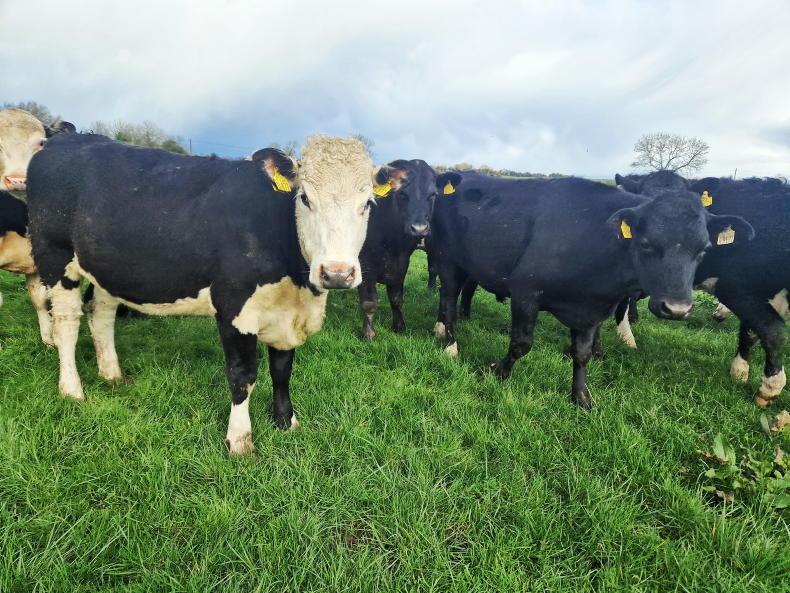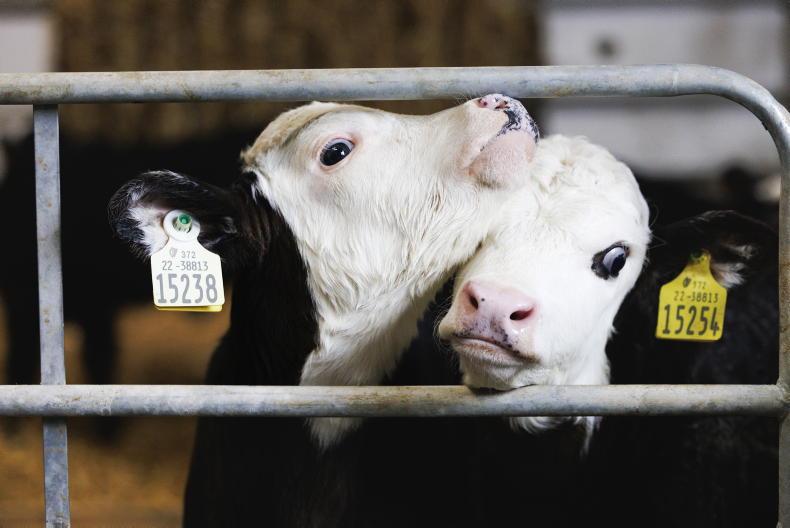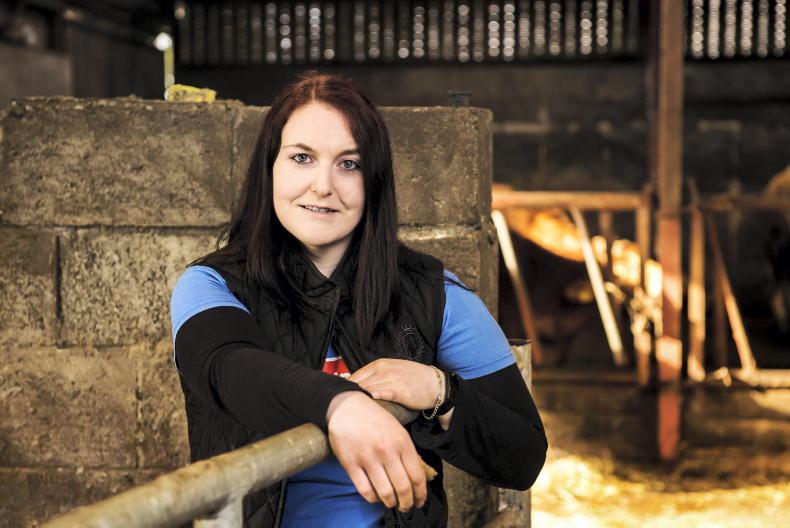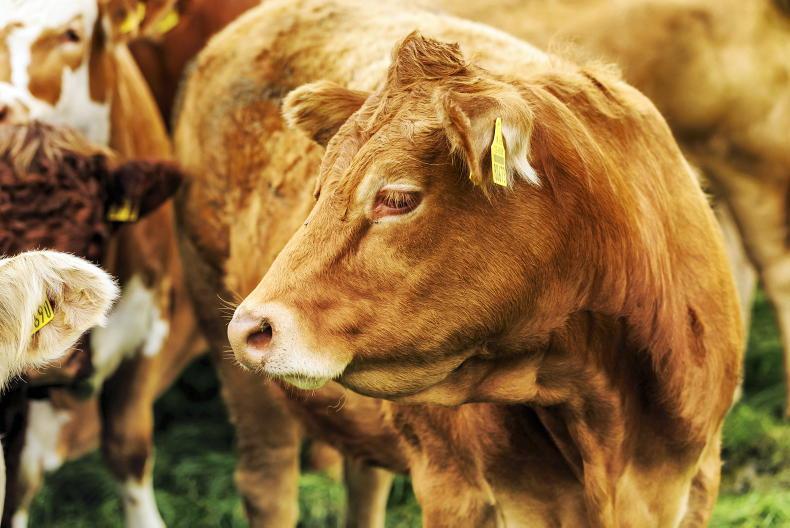A symbiotic relationship is one in which both parties mutually benefit from the interaction between the two.
Dairy beef requires this relationship between dairy farmers and beef farmers.
Dairy farmers need and want a market for their calves each year, while dairy beef farmers rely completely on the dairy farmer to produce stock that can go on and be profitable for their farm system.
In 2023, almost 60% of the beef produced in Ireland will derive from the dairy herd.
If we were to go back 10 or 12 years, this figure was below 40%.
A rapid increase in dairy cow numbers combined with the slow decline in suckler cows have led to this change.
With suckler cow numbers projected to decline further in the next 10 years, the proportion of beef coming from the dairy herd looks set to continue to rise.
Collaboration
There are huge challenges within the dairy beef industry from issues of calf quality, labour around calf rearing and, inevitably, the profitability of the entire system.
However, given the right focus and collaboration between dairy farmers, beef farmers and the wider industry, a lot of these issues can be eliminated or at least reduced in the coming years.
Genetics
With dairy expansion largely coming to a plateau, the focus is shifting from producing greater amounts of breeding females to a renewed focus on the beef calf.
This can only be seen as a positive with farmers looking to use better-quality beef bulls to produce higher beef merit calves for beef production.
The introduction of the dairy beef index (DBI) has been a positive step in providing information to farmers to select bulls that deliver in terms of calving ease and gestation length, but also deliver for beef traits such as conformation and carcase weight.
The DBI needs to be utilised more by dairy farmers and the focus needs to maximise the beef sub-index value within a certain calving ease range that farmers are comfortable with. Using a bull with a high overall DBI tells you very little about the quality of the resultant calf.
Also, farmers need to pick a team of beef bulls the same as they would for dairy bulls.
The bull selected for your maiden heifers will be very different from the one that you pick for mature cows.
This will help increase the beef characteristics of the calf. But is that going to be enough?
In 2010, the average dairy cow in Ireland had a beef sub-index value of -€7. Fast forward to 2021, this figure sat at -€13 and continues to decline today.
There has been much progress made on the beef offering from AI stations and indeed the beef sub-index of the DBI from bulls produced by pedigree breeders for dairy herds.
However, a significant proportion of this gain on the beef side is being eroded year after year by a dairy cow that is losing ground in terms of beef value.
The ICBF has altered the beef-sub index within the overall EBI but this doesn’t go far enough to stem the flow as of yet.
Genomics or DNA tagging of calves at birth will be the catalyst for driving change within the industry.
Good-quality calves will be easily identified as such and their sale value will reflect this.
On the other hand, those of a low beef merit will be more difficult to market and producers of such calves may have to look at bringing these animals through to beef themselves or indeed agree to a contract-rearing arrangement with a beef farmer in order to do so.
Calf slaughtering will be banned from next year and with live exports coming under increased pressure, prior to the upcoming breeding season, dairy farmers need to think long and hard about how they can maximise the beef value of their calf crop for next year in order to ensure there is a market for their stock.
Linking breeder and feeder
There is little doubt that more integration is needed within the system between dairy and beef farmers. However, this has proven a particularly difficult nut to crack.
There is a collaboration between some beef and dairy farmers and it is working well but the nature of the arrangement means it is difficult to drive significant change at pace.
For example, the calf that will be born from the beef straw used in a few weeks’ time, in all likelihood won’t produce a beef animal until spring 2026, almost three years from now.
Two more breeding seasons will be completed before there is feedback on the quality of that animal. That is why genomics is so badly needed to speed up this process.
From an economic point of view, finishing from grass rather than out of the shed is of huge importance
Where collaboration can and is working well is around calf health and welfare with many arrangements happening between neighbouring farms which reduces transport times and ultimately stress levels and sickness levels in calves.
This is going to become of greater importance in years to come. Through selective breeding and perhaps sexed semen, is there a production system that can see dairy beef animals fit for slaughter at a greater scale during or at the end of the second grazing season?
From an economic point of view, finishing from grass rather than out of the shed is of huge importance and while there may be a need to accept a lower carcase weight, if we can produce high-quality beef at a younger age with a lower carbon footprint, there is likely to be a demand for such a product in the years to come.
While genetics will play a pivotal role in this, the nutrition of the animal will also be paramount.
Top-quality pasture management will be a must. I say pasture rather than grass as the increased focus on the likes of clover and herbs is set to continue and will become more mainstream in the next five to 10 years.
Everything discussed up to this point is irrelevant if the systems of the future cannot support the family farm and leave a positive margin for producers that will keep them in these systems for the long term.
From a beef farmer’s point of view, more and more are now part-time with full-time off-farm employment.
Younger generations also place a greater emphasis on work-life balance and so will not remain in a system if is not returning a profit.
A symbiotic relationship is one in which both parties mutually benefit from the interaction between the two.
Dairy beef requires this relationship between dairy farmers and beef farmers.
Dairy farmers need and want a market for their calves each year, while dairy beef farmers rely completely on the dairy farmer to produce stock that can go on and be profitable for their farm system.
In 2023, almost 60% of the beef produced in Ireland will derive from the dairy herd.
If we were to go back 10 or 12 years, this figure was below 40%.
A rapid increase in dairy cow numbers combined with the slow decline in suckler cows have led to this change.
With suckler cow numbers projected to decline further in the next 10 years, the proportion of beef coming from the dairy herd looks set to continue to rise.
Collaboration
There are huge challenges within the dairy beef industry from issues of calf quality, labour around calf rearing and, inevitably, the profitability of the entire system.
However, given the right focus and collaboration between dairy farmers, beef farmers and the wider industry, a lot of these issues can be eliminated or at least reduced in the coming years.
Genetics
With dairy expansion largely coming to a plateau, the focus is shifting from producing greater amounts of breeding females to a renewed focus on the beef calf.
This can only be seen as a positive with farmers looking to use better-quality beef bulls to produce higher beef merit calves for beef production.
The introduction of the dairy beef index (DBI) has been a positive step in providing information to farmers to select bulls that deliver in terms of calving ease and gestation length, but also deliver for beef traits such as conformation and carcase weight.
The DBI needs to be utilised more by dairy farmers and the focus needs to maximise the beef sub-index value within a certain calving ease range that farmers are comfortable with. Using a bull with a high overall DBI tells you very little about the quality of the resultant calf.
Also, farmers need to pick a team of beef bulls the same as they would for dairy bulls.
The bull selected for your maiden heifers will be very different from the one that you pick for mature cows.
This will help increase the beef characteristics of the calf. But is that going to be enough?
In 2010, the average dairy cow in Ireland had a beef sub-index value of -€7. Fast forward to 2021, this figure sat at -€13 and continues to decline today.
There has been much progress made on the beef offering from AI stations and indeed the beef sub-index of the DBI from bulls produced by pedigree breeders for dairy herds.
However, a significant proportion of this gain on the beef side is being eroded year after year by a dairy cow that is losing ground in terms of beef value.
The ICBF has altered the beef-sub index within the overall EBI but this doesn’t go far enough to stem the flow as of yet.
Genomics or DNA tagging of calves at birth will be the catalyst for driving change within the industry.
Good-quality calves will be easily identified as such and their sale value will reflect this.
On the other hand, those of a low beef merit will be more difficult to market and producers of such calves may have to look at bringing these animals through to beef themselves or indeed agree to a contract-rearing arrangement with a beef farmer in order to do so.
Calf slaughtering will be banned from next year and with live exports coming under increased pressure, prior to the upcoming breeding season, dairy farmers need to think long and hard about how they can maximise the beef value of their calf crop for next year in order to ensure there is a market for their stock.
Linking breeder and feeder
There is little doubt that more integration is needed within the system between dairy and beef farmers. However, this has proven a particularly difficult nut to crack.
There is a collaboration between some beef and dairy farmers and it is working well but the nature of the arrangement means it is difficult to drive significant change at pace.
For example, the calf that will be born from the beef straw used in a few weeks’ time, in all likelihood won’t produce a beef animal until spring 2026, almost three years from now.
Two more breeding seasons will be completed before there is feedback on the quality of that animal. That is why genomics is so badly needed to speed up this process.
From an economic point of view, finishing from grass rather than out of the shed is of huge importance
Where collaboration can and is working well is around calf health and welfare with many arrangements happening between neighbouring farms which reduces transport times and ultimately stress levels and sickness levels in calves.
This is going to become of greater importance in years to come. Through selective breeding and perhaps sexed semen, is there a production system that can see dairy beef animals fit for slaughter at a greater scale during or at the end of the second grazing season?
From an economic point of view, finishing from grass rather than out of the shed is of huge importance and while there may be a need to accept a lower carcase weight, if we can produce high-quality beef at a younger age with a lower carbon footprint, there is likely to be a demand for such a product in the years to come.
While genetics will play a pivotal role in this, the nutrition of the animal will also be paramount.
Top-quality pasture management will be a must. I say pasture rather than grass as the increased focus on the likes of clover and herbs is set to continue and will become more mainstream in the next five to 10 years.
Everything discussed up to this point is irrelevant if the systems of the future cannot support the family farm and leave a positive margin for producers that will keep them in these systems for the long term.
From a beef farmer’s point of view, more and more are now part-time with full-time off-farm employment.
Younger generations also place a greater emphasis on work-life balance and so will not remain in a system if is not returning a profit.










SHARING OPTIONS